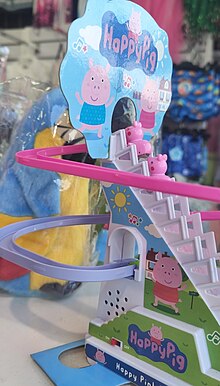Dupe (product)
A dupe (duplicate) or knockoff is a product similar in appearance, functionality, or design to a higher-end, often more expensive, branded item but sold at a much lower price. Unlike counterfeit products, dupes do not copy trademarked brand names or logos and are often sold at mainstream retailers. The term dupe or knockoff is often used as a pejorative to infer inferior quality, and is often used synonymously with ripoff, replica, imitation and clone.[1]
Description
[edit]

Dupes are products similar in appearance, functionality, or design to higher-end, often more expensive, branded items but sold at a much lower price. These products offer consumers an affordable alternative to luxury goods without significantly compromising quality or style. Dupes are particularly popular in fashion, beauty, and electronics, where the desire for trendy or high-performance items meets budget constraints. Social media platforms and influencers play a significant role in promoting dupes by sharing their discoveries and recommendations with their audiences.[2][3][4]
The term counterfeit is often used interchangeably, although their legal meanings are not identical. Knockoff products are those that copy or imitate the physical appearance of other products but which do not copy the brand name or logo of a trademark.[1][5] They may still be illegal under trademark laws if they confuse consumers or violate patents.[6][7]
History
[edit]Fashion
[edit]The concept of knockoff clothing dates back to the early 1900s, when designers would copy clothing from Paris fashion houses. In the United States, department stores would manufacture copies of the latest popular designs from Paris or worn by Hollywood performers. Around 1913, French designer Paul Poiret discovered inexpensive replicas of his designs were being sold in the United States. In the 1940s, around the time designers began putting visible labels on their clothing, French fashion houses like Chanel and Dior would license their designs and provide materials to American department stores to manufacture knockoffs, which would be sold alongside their higher-priced authentic counterparts.[8]
Apparel (clothing, shoes, accessories, etc.) are classified as "functional items" and their designs are generally not protected by copyright laws in the many countries, including the United States and United Kingdom.[9] According to the U.S. Copyright Office, designs of useful articles like clothing and accessories are only protected "to the extent that, such design incorporates pictorial, graphic, or sculptural features that can be identified separately from, and are capable of existing independently of, the utilitarian aspects of the article."[10] While some designs can be protected with a design patent that lasts 15 years, the cost and time to receive a design patent, which is typically over year, can be prohibitive due to the cyclical and seasonal nature of fashion.[11][12]
Dupe culture, driven largely by Gen Z and Millennials, has emerged as a significant trend in the shopping world. These generations are increasingly seeking out dupes, which are affordable alternatives to high-end products, in an effort to maintain style without breaking the bank. This movement is fueled by social media, where influencers and users share their favorite dupes, promoting accessibility and savvy shopping. High-end brands are encouraged to embrace this trend, recognizing the cultural shift towards valuing aesthetics and financial prudence.[2][3][4]
Furniture
[edit]Knockoffs are pervasive in the furniture industry. In the United States, furniture designs can be protected by design patents that last for 15 years, but are typically not eligible for trademark protection as a functional product. In Europe, furniture designs are protected as intellectual property.[13] Architectural Digest noted with the rise of e-commerce, "hundreds of home decor sites [sell] knockoff Eames, Kartell, and Le Corbusier models at IKEA prices."[14] The Eames Lounge Chair has been cited as one of the most copied pieces of furniture.[15] Its manufacturer, Herman Miller, launched a campaign warning customers about knockoff products in 1957.[13]
See also
[edit]- Mockbuster, a film created to exploit the publicity of another major motion picture with a similar title or subject
- Video game clone, a video game made to capitalize on a popular title
- Generic brand, similar quality products sold without brand name recognition
References
[edit]- ^ a b Mull, Amanda (2023-02-24). "Shoppers Are Stuck in a Dupe Loop". The Atlantic. Retrieved 2023-04-16.
- ^ a b Solá, Ana Teresa (2023-10-31). "With Gen Z, millennials now the biggest 'dupe' shoppers, online culture has 'flipped the script,' analyst says". CNBC. Retrieved 2024-07-01.
- ^ a b Hill, Amelia (2024-05-20). "Counterfeit goes cool: high-end brands urged to embrace rise of #dupe". The Guardian. ISSN 0261-3077. Retrieved 2024-07-01.
- ^ a b Judkis, Maura (2023-03-23). "In Gen Z's world of 'dupes,' fake is fabulous — until you try it on". Washington Post. ISSN 0190-8286. Retrieved 2024-07-01.
- ^ "Counterfeiting (Intended for a non-legal audience)". International Trademark Association. Retrieved 2024-10-11.
- ^ "Dupes Are the Legal Problem That May Be Lurking in Your Closet". Mic. March 30, 2016. Retrieved 2023-04-25.
- ^ "Knock-off the Knockoffs: The Fight Against Trademark and Copyright Infringement – Illinois Business Law Journal". 2009-09-21. Retrieved 2023-09-25.
- ^ "A Deep Dive Into Fashion's Obsession With Fakes". W Magazine. 2022-12-13. Retrieved 2023-05-19.
- ^ "What are the consequences of copycats?", by Helena Pike, March 14, 2016, Business of Fashion
- ^ Tongco, Tricia (2016-08-29). "The Absurd Reason Why Corporations Can Legally Get Away With Copying Fashion Designs". ATTN. Retrieved 2023-05-19.
- ^ TFL (2016-07-26). "Design Patents and Trade Dress: A Noteworthy Fashion Pairing". The Fashion Law. Retrieved 2023-05-19.
- ^ "Fashion designers look to patents to fight knockoffs". Reuters. 2013-09-12. Retrieved 2023-05-19.
- ^ a b Goodman, Jessica (2022-12-14). "How E-Commerce Changed the Knockoff Furniture Game". Dwell. Retrieved 2023-05-29.
- ^ "How Knockoff Furniture Could Destroy the Design Industry". Architectural Digest. 2017-09-13. Retrieved 2023-05-29.
- ^ "There's a huge global black market for fake "designer" chairs". Quartz. 2017-07-24. Retrieved 2023-05-29.
